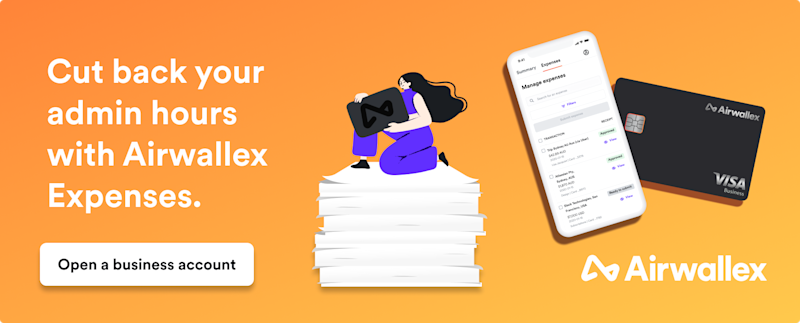The pain-free guide to managing business expenses

No business, regardless of industry or products and services offered, can get away from the not-so-thrilling task of expense management. Submitting and reviewing receipts for validation, while mundane, is absolutely essential to the success of every business.
But what many businesses don’t realise is that expense management doesn’t have to be as hard — or even as tedious — as it was in the past.
Whether your business is brand-new and needs to implement expense management processes for the first time, or simply needs to improve current operations, our pain-free guide to expense management is for you.
The importance of proper business expense management
Finances are always a crucial element of making strategic business decisions. But getting a clear picture of your money going in and out of your business is easier said than done. It takes the average small business over a week to approve a claim for reimbursement.
Proper business travel and expense management makes all the difference.
When handled effectively, business expense management can increase:
Visibility: Established processes for tracking expenses and reporting enable your business to gain insights quickly and at a highly granular level. Whenever management teams need information on expenditures, it will be readily available — no scrambling to go through reports necessary. This represents an invaluable resource that will come to drive your business strategy.
Control: Expenses are often submitted outside of policy or with incorrect or missing information. In fact, a 2015 survey from the Global Business Travel Association (GBTA) Foundation and HRS found that an average of 19% of submitted expense reports have errors. Even when unintentional and seemingly minor, these issues can pose problems when it comes to meeting compliance requirements and avoiding fraud. Implementing expense management tools that automatically check for such issues can save your finance team hours of admin performing manual checks, preventing human error and maintaining compliance.
Productivity: According to the same GBTA Foundation and HRS survey mentioned above, the average expense report takes 20 minutes to complete, which costs $58 in manpower. And the reports that end up having errors take an additional 18 minutes and $52 to correct. An expense management tool that automates these processes can prevent the human error that leads to corrections, save money and free up employees to carry out their actual work.

How to manage business expenses: 6 tips
These six simple steps will get your business travel and expense management system up and running in no time.
Recruit your finance team
In the early days, a lot of founders or CEOs find themselves solely responsible for their business’ expense management. But a dedicated finance team will likely be necessary as soon as a business starts to grow.
Not only will you have more time to focus on growing your business, you can feel confident that those handling your finances are qualified to do so.
This team will be responsible for managing income, expenditures, forecasting, and budgeting. From running granular daily operations to providing insights that will drive big decisions, your finance team will be crucial to your business’ long-term success.
Outline processes for submitting and validating expenses
Make it as easy as possible to manage your expenses by outlining processes for submitting and validating them.
Simply turning over receipts to a dedicated person or place may work for small teams. But this solution quickly becomes a mess of paperwork as teams grow.
This is when you’ll want to start thinking about automating the process. To simplify even further, consider creating a workflow that eliminates paperwork rather than creating more.
Keep the following in mind when outlining your processes:
Card issuance: Who should be assigned a corporate card, and what is the process for issuing cards? Will you use physical cards or virtual cards?
Budget allocation: Will you assign specific budgets to different teams?
Acceptable expense types and thresholds: What kind of expenses will be validated, and is there a maximum amount for each expense type that employees can spend? For example, businesses typically set a per diem amount for meals on business trips.
Expense documentation: What paperwork do employees need to submit in order to validate their expenses? Just a receipt, or something more?
Having simple processes in place for real-time expense validation gives you up-to-date insight into current spending — no more waiting until the month’s end to know where you’re at.
Use secure payment methods
Anyone who has worked in a startup or small business has likely had to ask for the company credit card to make a purchase. But sharing a single card becomes increasingly difficult as teams grow and become more remote — not to mention the likelihood of cards getting lost.
Nowadays there are many more modern options, specifically designed to support remote teams, prevent loss, and reduce misuse.
For example, virtual cards allow you to instantly create new cards for immediate use — regardless of where you and your team members are located. Assign virtual cards to specific team members with specific one-time or monthly budgets and get instant insight into purchases as they happen.
Some virtual cards, like our multi-currency cards, even facilitate global purchases. We don't charge you any international transaction fees and offer better foreign exchange (FX) rates than the banks. This is especially important if you have employees or vendors overseas, regularly travel abroad for business or source foreign products or services.
Establish spending guidelines
You may have already considered spending guidelines when outlining your processes for submitting expenses, but they’re important enough to warrant their own step.
As explained above, outline which types of expenses will be reimbursed or approved and include a spending cap for each expense type. Types of expenses that may apply to your business include:
Client meetings
Events
Entertainment
Business travel airfare
Ground transportation (gas, rental cars, bus/train tickets, etc.)
Conferences
Meals
Lodging
Parking
Office supplies
Equipment
Tools and solutions
Vendors
Be as specific as possible and be sure to include differences for cards specific to individual employees and departments versus general corporate cards. If individuals may have access to multiple cards, be sure it’s clear which expense types should be charged to each card.
Be prepared to reject inappropriate expenses
No one wants to have to deny a request for reimbursement or approval. But the truth is that employee expense fraud is more common than most people realise.
In a 2019 survey from Robert Half Management Resources, 56% of CFOs reported having seen an increase in inappropriate submissions within the past three years. What’s more, travel and expense (T&E) fraud alone makes up 14.5% of all uncovered fraud.
So be prepared to reject unauthorised expenses, and don’t be surprised by widely inappropriate purchases. CFOs in the same Robert Half survey mentioned above cited all of the following outrageous submissions:
Pogo stick
300 tacos
Chicken statue with a top hat
Bed bug removal
Hot air balloon ride
$500 cowboy boots
Trip to Italy
Lamborghini
Yacht
Whether an employee is requesting $20 for a pogo stick or $500,000 for a yacht, or merely spending more on dinner than necessary, you’re absolutely in your right to deny the request.
To make things easier, Borderless cards enable you to allow only specific merchant types and set up notifications for large or unusual purchases.
Implement an expense management tool
There’s a tool to make just about everything easier these days, including expense management.
Expense management tools are designed to eliminate all manual tasks associated with expense management. They save time, increase productivity, eliminate human error and lend greater insights into your business’ finances.
For example, Airwallex’s Expenses and Xero integration enable:
Card spending limits: Implement card spending limits for specific use cases, such as travel or client meetings.
Easy receipt uploading: Employees can easily log and categorise their transactions, upload receipts and track their expenses.
Seamless approval workflows: A few clicks are all it takes to submit, review, and approve expenses — no physical paperwork necessary.
Expense tracking: Track spending by employee or card to maintain an up-to-date total.
Reporting: Sync your receipts and expense data to facilitate month-end reporting and reconciling.
Compliance: Store all of your receipts and tax invoices in one place to ensure you’re never out of compliance.
Make business expense management easier with Airwallex
Our Borderless cards now feature built-in expense management to turn the back-and-forth with finance into an automatic and seamless workflow. Sign up for a free account today for enjoy easier, more accurate and more efficient expense management.
Share

Writer, content strategist and storyteller. Shani is a digital marketer with a passion for brand storytelling and empathy-led copywriting. Responsible for Airwallex's content marketing efforts in Australia, and other parts of the world.


